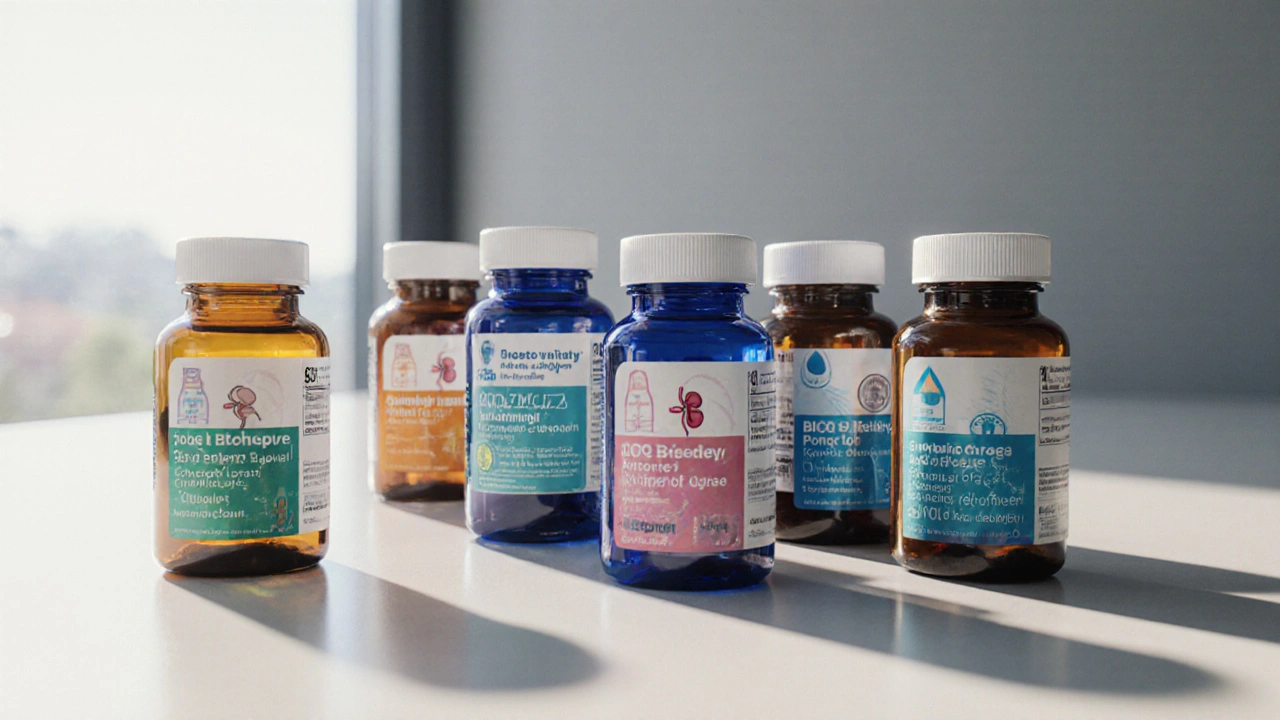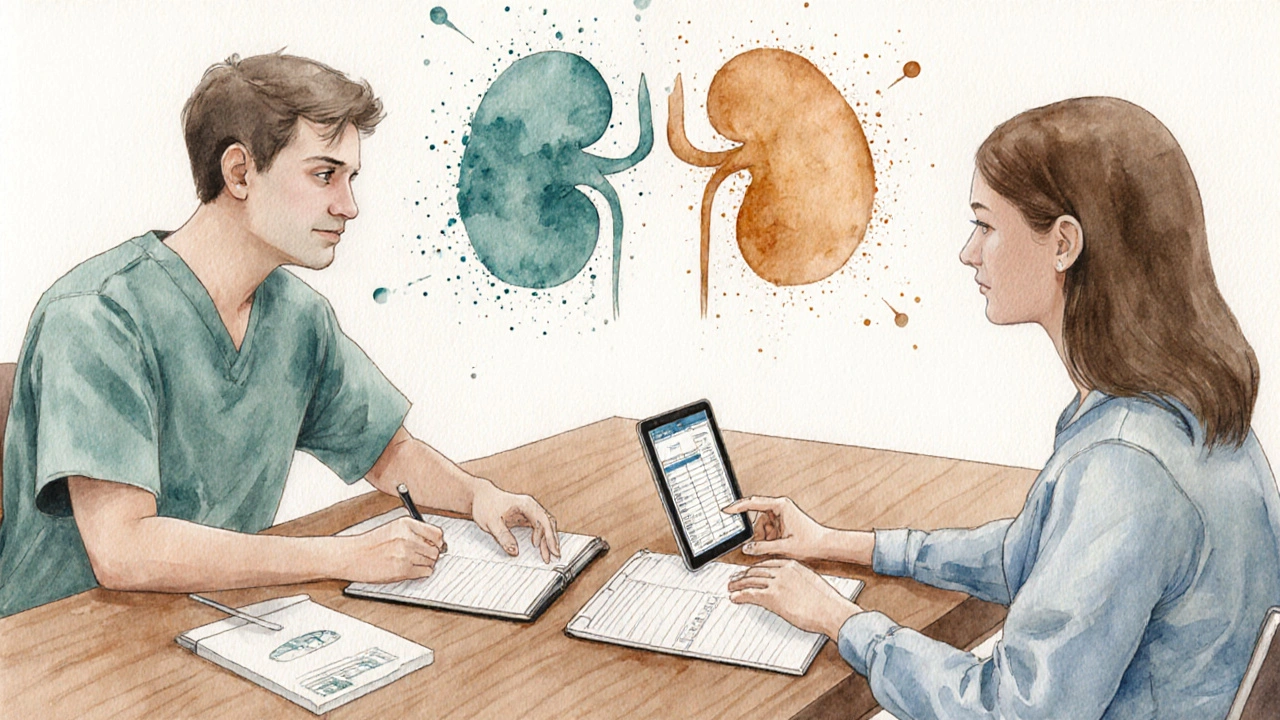Cyclosporine vs Alternatives: Which Immunosuppressant Fits Your Needs

Immunosuppressant Selection Guide
Compare Drugs Based on Key Factors
Select criteria below to find the most suitable immunosuppressant for your situation.
Recommended Drug for You
Detailed Comparison
Choosing the right drug to keep an organ transplant or autoimmune condition under control can feel like navigating a maze. Cyclosporine alternatives are many, each with its own strengths, side‑effect quirks, and cost profile. This guide cuts through the noise, comparing the most common options side‑by‑side so you can see which one lines up with your health goals, lifestyle, and budget.
- Quick snapshot of how Cyclosporine stacks up against its rivals.
- Key factors to weigh: mechanism, effectiveness, safety, and price.
- Real‑world tips for monitoring and managing side effects.
- Answers to the most common questions patients ask.
What is Cyclosporine?
Cyclosporine is a calcineurin inhibitor that suppresses the immune system by blocking T‑cell activation. First approved in the early 1980s, it quickly became a cornerstone for preventing organ rejection in kidney, liver, and heart transplants, as well as for treating severe psoriasis and rheumatoid arthritis. The drug is usually taken orally in capsule form, though an intravenous version exists for hospital use.
Major Alternatives at a Glance
While Cyclosporine works well for many, newer agents often offer smoother side‑effect profiles or easier dosing. Below are the six most frequently considered alternatives, each introduced with a short definition.
Tacrolimus (also known as FK‑506) is another calcineurin inhibitor that blocks the same pathway as Cyclosporine but is generally considered more potent on a milligram‑per‑milligram basis. It is available as a capsule, extended‑release tablet, and topical ointment for skin conditions.
Mycophenolate mofetil (MMF) belongs to the antimetabolite class. It hinders the proliferation of B and T lymphocytes by inhibiting the enzyme inosine‑5′‑monophosphate dehydrogenase. MMF is usually given twice daily in tablet form.
Sirolimus, marketed as Rapamune, is an mTOR inhibitor that prevents cell growth and proliferation. It is less nephrotoxic than calcineurin inhibitors and can be combined with low‑dose Cyclosporine or Tacrolimus for synergistic effect.
Corticosteroids (e.g., prednisone, methylprednisolone) act broadly by dampening inflammation and immune responses. They are often used in the early post‑transplant period or as a bridge while other agents reach therapeutic levels.
Azathioprine is a purine analogue that interferes with DNA synthesis in rapidly dividing cells, including lymphocytes. It is taken orally once or twice daily and is often used in combination therapy.
Belatacept is a selective costimulation blocker administered by intravenous infusion. It was approved for kidney transplant maintenance and is known for a lower risk of chronic kidney disease progression compared with calcineurin inhibitors.

Side‑by‑Side Comparison
| Drug | Class | Typical Indications | Mechanism | Renal Impact | Common Side Effects | Typical Cost (UK, per month) |
|---|---|---|---|---|---|---|
| Cyclosporine | Calcineurin inhibitor | Kidney, liver, heart transplant; severe psoriasis | Blocks calcineurin → ↓ IL‑2 | Nephrotoxic (dose‑dependent) | Hypertension, gum hyperplasia, tremor, hirsutism | £80‑£120 |
| Tacrolimus | Calcineurin inhibitor | Kidney, liver, heart transplant; atopic dermatitis | Blocks calcineurin → ↓ IL‑2 (more potent) | Potentially less nephrotoxic than Cyclosporine | Diabetes, neurotoxicity, tremor, GI upset | £90‑£150 |
| Mycophenolate mofetil | Antimetabolite | Kidney & liver transplant, lupus nephritis | Inhibits inosine‑5′‑monophosphate dehydrogenase | Minimal renal toxicity | GI cramps, leukopenia, infection risk | £70‑£110 |
| Sirolimus | mTOR inhibitor | Kidney transplant, coronary‑stent patients | Blocks mTOR → ↓ cell proliferation | Non‑nephrotoxic; may cause hyperlipidemia | Hyperlipidemia, delayed wound healing, mouth ulcers | £100‑£160 |
| Corticosteroids | Steroid | Early post‑transplant, acute rejection episodes | Broad immune suppression via glucocorticoid receptors | Can cause fluid retention, worsening kidney function in high doses | Weight gain, osteoporosis, mood swings | £10‑£30 |
| Azathioprine | Purine analogue | Kidney transplant, inflammatory bowel disease | Blocks DNA synthesis in lymphocytes | Low renal impact | Bone marrow suppression, liver toxicity | £25‑£45 |
| Belatacept | Costimulation blocker | Kidney transplant maintenance | Blocks CD80/CD86 → CD28 interaction | Kidney‑friendly (lower chronic nephrotoxicity) | Infusion reactions, PTLD risk | £300‑£450 (infusion cost) |
Decision Criteria: How to Choose the Right Agent
Picking a drug isn’t just about efficacy; it’s a balance of several factors. Use the checklist below to see which points matter most to you:
- Renal safety: If you already have reduced kidney function, favor agents with low nephrotoxicity (e.g., MMF, Sirolimus, Belatacept).
- Side‑effect tolerance: Some patients can’t handle the gum overgrowth of Cyclosporine or the diabetes risk of Tacrolimus.
- Drug‑interaction profile: Cyclosporine and Tacrolimus are metabolized by CYP3A4, meaning many antibiotics, antifungals, and statins can bump their levels.
- Convenience: Oral tablets (Cyclosporine, Tacrolimus, MMF) versus IV infusions (Belatacept) affect daily routines.
- Cost & insurance coverage: Generic Cyclosporine is widely covered, whereas Belatacept may need prior authorization.
Discuss these points with your transplant team. Often the final regimen is a combination - for example, low‑dose Tacrolimus plus MMF - to capitalize on synergy while minimizing each drug’s downside.
Safety Profiles: What to Watch For
All immunosuppressants raise infection risk, but each has its own signature warnings.
- Cyclosporine: Monitor blood trough levels every week initially, then monthly. Watch blood pressure, serum creatinine, and lipid panels.
- Tacrolimus: Check fasting glucose and tacrolimus trough levels. Neurotoxicity (tremor, seizures) can appear at high concentrations.
- Mycophenolate mofetil: Full blood counts weekly for the first month. GI upset is common; taking with food can help.
- Sirolimus: Lipid profile every 3 months. Healing of surgical wounds may be delayed - inform surgeons before procedures.
- Corticosteroids: Bone density scans if used >3 months. Screen for hypertension and glucose intolerance.
- Azathioprine: TPMT enzyme testing before start to avoid bone‑marrow toxicity.
- Belatacept: Screen for EBV serostatus; EBV‑negative patients are at higher PTLD risk.

Cost and Accessibility in the UK
Price matters, especially when a medication becomes a lifelong requirement.
- Cyclosporine and Tacrolimus are both available as NHS‑prescribed generics, typically costing under £150 per month.
- MMF is slightly cheaper, but some patients need the brand version (CellCept) for insurance reimbursement.
- Sirolimus and Belatacept are pricier and may need special funding approvals.
- Corticosteroids are the most affordable, but long‑term use can lead to costly complications.
Ask your pharmacist about patient assistance programs - many manufacturers offer discounts for those paying out‑of‑pocket.
Practical Tips for Patients on Immunosuppressants
- Adherence is king: Missing a dose can trigger acute rejection. Set alarms or use pill‑organizer apps.
- Never skip labs: Blood tests track drug levels and organ function. Keep a log and bring it to each appointment.
- Watch for drug interactions: Over‑the‑counter pain relievers, herbal supplements (St. John’s Wort), and certain antibiotics can spike levels.
- Stay vaccinated: Inactivated vaccines (flu, pneumococcal) are safe; live vaccines are generally contraindicated.
- Report infections early: Fever, cough, or skin lesions should prompt a call to your transplant team.
Frequently Asked Questions
Is Cyclosporine still the best first‑line drug for kidney transplants?
Many centers now start with Tacrolimus because studies show slightly lower acute rejection rates and a more favorable side‑effect profile for kidney patients. However, Cyclosporine remains a solid option, especially if a patient cannot tolerate Tacrolimus’s impact on blood sugar.
Can I switch from Cyclosporine to Mycophenolate without a washout period?
Usually yes, but the transition should be overseen by a transplant physician. Blood levels of Cyclosporine are tapered while MMF is introduced, keeping the overall immunosuppressive load stable.
What is the biggest advantage of Belatacept over calcineurin inhibitors?
Belatacept’s main benefit is protecting long‑term kidney function. Patients on Belatacept tend to have less chronic nephrotoxicity, which can translate into better graft survival over many years.
How often should I have my blood levels checked when on Tacrolimus?
Initially weekly for the first month, then every 2‑4 weeks until stable. Once steady, most clinics shift to a 3‑month interval, unless you change doses or start a new interacting medication.
Are there diet restrictions while taking these immunosuppressants?
Avoid grapefruit and its juice because they inhibit CYP3A4, which can raise Cyclosporine and Tacrolimus levels. Keep sodium low if you’re prone to hypertension, and discuss any high‑potassium foods if you’re on ACE inhibitors alongside your transplant meds.


Sahithi Bhasyam
Wow,, this guide is super helpfull,, thanks for sharing! 😊
mike putty
I really appreciate how the guide lays out the pros and cons of each drug in plain language. It makes the decision process feel a lot less intimidating. The check‑list for renal safety and side‑effect tolerance is especially useful for patients who are juggling multiple health issues. Also, the practical tips about lab monitoring and drug interactions are gold. Keep up the great work, this kind of clear information is exactly what the community needs.
Kayla Reeves
Reading this, I can’t help but notice how many people still ignore the ethical implications of long‑term immunosuppression. It’s not just a medical choice; it’s a moral one that affects the whole community.
Abhinanda Mallick
As an Indian professional deeply invested in the advancement of our nation's healthcare, I find this comparative analysis both enlightening and essential. The detailed breakdown of nephrotoxicity resonates with the concerns we face in our transplant centers, where renal preservation is paramount. Highlighting Tacrolimus as potentially less nephrotoxic than Cyclosporine aligns with recent Indian studies published in the Indian Journal of Transplantation. Moreover, the inclusion of cost considerations reflects the economic realities of our patients, many of whom rely on subsidized schemes. The table’s clear layout, with mechanisms and side‑effects side by side, allows clinicians to make rapid, evidence‑based decisions. I must also commend the emphasis on drug‑interaction vigilance; in a country where polypharmacy is common, CYP3A4 interactions can be a silent danger. The guidance on avoiding grapefruit, a popular fruit in our diet, shows cultural sensitivity. While the guide mentions Belatacept’s high cost, it could further explore local funding programs that may offset this burden. The practical tips section, especially regarding adherence tools like mobile reminders, could be expanded to include region‑specific apps popular among Indian users. Finally, a note on the emerging role of biosimilars in the Indian market would make this guide future‑proof. Overall, this resource bridges the gap between global best practices and our local context, and I wholeheartedly recommend its dissemination across Indian transplant forums.
Richard Wieland
Great point about labs – regular trough level checks are a lifesaver.
rachel mamuad
The nuanced discussion on mTOR inhibitors really hits the mark; sirolimus' lipid profile management is often under‑addressed in standard guidelines. Also, note the slight typo in "hyperlipidemia" – a minor slip but worth fixing.
Amanda Anderson
This guide feels like a breath of fresh air amid the endless clinical jargon.
Carys Jones
Honestly, it’s hard to believe anyone would still champion Cyclosporine as the go‑to when newer agents have clearer safety profiles. The drama of side‑effects shouldn’t be romanticized.
Roxanne Porter
The cost breakdown for the UK market is particularly useful; noting that generic Cyclosporine and Tacrolimus remain under £150 per month helps patients budget effectively.
Jonathan Mbulakey
Agreed, transparent pricing is essential for long‑term adherence.